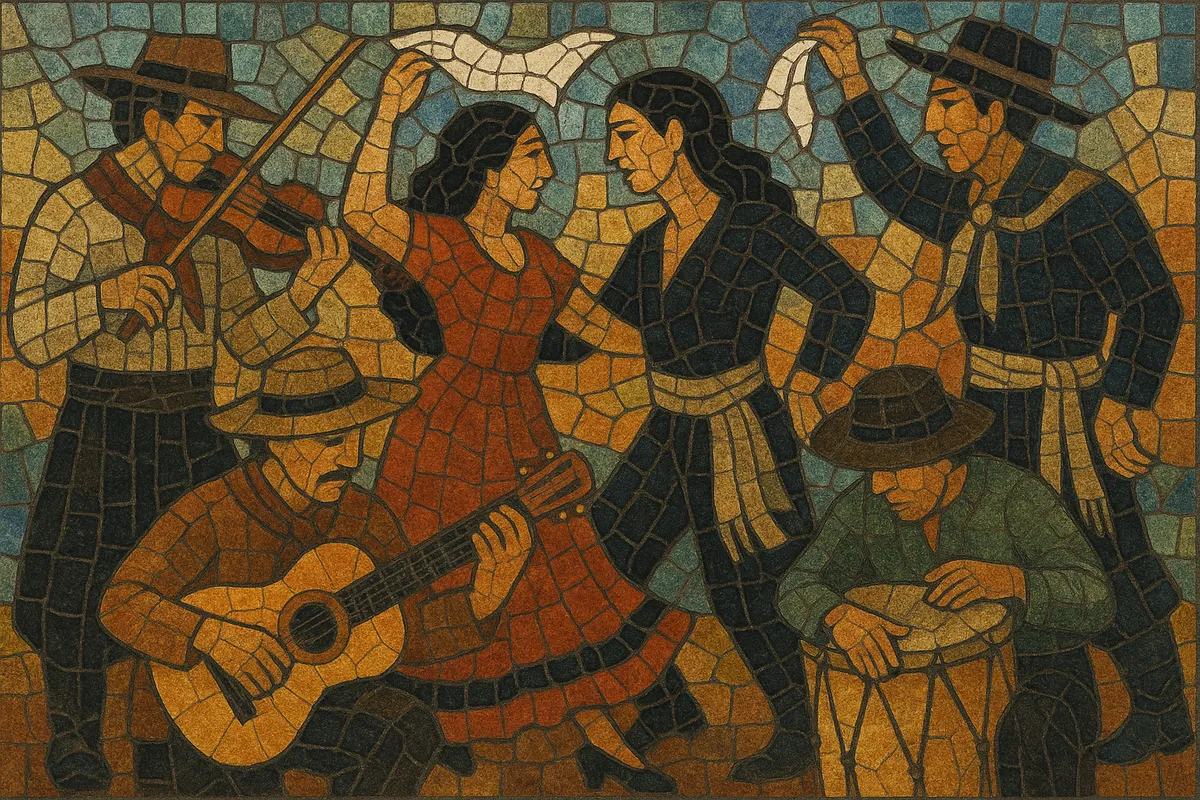Chacarera is a traditional Argentine folk genre and partner dance that emerged in the rural province of Santiago del Estero. It is typically played on guitar, violin, and bombo legüero, with singers delivering verses in the copla tradition. The music features the characteristic Latin American hemiola, alternating or superimposing 6/8 and 3/4 feels to create forward motion and a lively, swaying groove.
Dancers face each other in lines and never embrace, using handkerchiefs to flirt and mark figures such as vueltas, zapateo (percussive footwork), zarandeo (graceful shaking), and coronación. Musically, chacareras often employ simple harmonic progressions (I–V–I with modal color), catchy violin melodies, rasgueado guitar strums, and the deep pulse of the bombo. Variants include the chacarera simple, chacarera doble (extended structure), and chacarera trunca (with a compelling, "tripped" accent pattern).
Chacarera took shape in the 1800s in Santiago del Estero, Argentina, where Iberian song-dance forms (such as seguidilla and fandango) mingled with indigenous and criollo traditions. The poetic form of the copla, rural guitar practices, and the bombo legüero’s earthy pulse helped define its identity. The hallmark hemiola—alternating or superimposing 6/8 and 3/4—links it to broader Hispanic dance lineages (cueca/zamacueca) while its phrasing, accentuation, and regional Spanish/Quechua lexicon ground it in the Argentine Northwest.
In the early 1900s, folklorist-performer Andrés Chazarreta and ensembles from Santiago del Estero carried the genre to urban stages and national radio, codifying dance figures and ensemble formats. This period established the classic trio of guitar, violin, and bombo, and standardized choreographic sequences for social and stage performance.
Groups like Los Hermanos Ábalos and Los Chalchaleros popularized chacarera across Argentina. The growth of festivals (later including the Festival Nacional de la Chacarera and the Cosquín Festival) and radio/record industries brought the music into living rooms nationwide. Repertoires expanded with regional variants—simple, doble, and trunca—giving performers distinct rhythmic profiles while preserving the core identity.
Artists associated with the broader Latin American song movements—most notably Atahualpa Yupanqui and Mercedes Sosa—elevated chacarera as a symbol of identity and social reflection. Arrangers and bandleaders (e.g., Peteco Carabajal, Horacio Banegas) folded in elements from rock, expanded harmonies, and modern production while keeping the bombo’s heartbeat and the danceable hemiola intact.
Today, chacarera thrives in peñas (folk gatherings), festival stages, and cross-genre collaborations. Ensembles range from intimate acoustic trios to larger bands with electric bass and drum set. While the traditional dance remains central, contemporary artists experiment with form, timbre, and arrangement, ensuring the style’s continuity and evolution.


